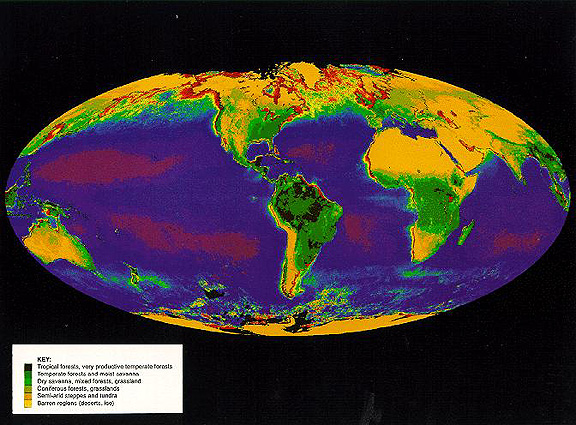
Lets switch attention now to the world's forests - both natural and those planted and maintained for future harvesting. The distribution of these forests, along with other principal types of vegetation in the global biosphere, can be determined and refined on a periodic basis, by analysis of Vegetation Index data acquired by satellites. As an example, here is a plot of the distribution of general classes as identified in AVHRR data from NOAA 7 and 9 metsats. Colors not identified in the legend include red = shallow, coastal or inland waters; blue = ocean waters; purple = deep ocean; black in the arctic and antarctic regions = not classified.

One obvious application lies in determining the geographic and areal distribution of major types of sylvan vegetation and their ecological settings. Generally, Landsat and other remote sensing systems can readily distinguish between deciduous and coniferous forests, and can recognize shrublands, savannah, and various desert ecosystems. But, identifying most tree types at the species level proves much more difficult unless high resolution images are available and the trees have distinctive crowns and leaf shapes that produce fairly explicit spectral signatures. Easier tasks, that have widespread applications, involve discernment of defoliation - either in the extreme with tree removal by clearcutting or through denudation of leaves by insects, and assessment of forest fire or storm damage.
The Amazon Rain Forest; Deforestation
Clearcutting in parts of the world has become almost epidemic
and is the subject of much environmental concern, both because
of habitat destruction and biochemical threats to the atmosphere
in disturbing the balance between oxygen generation and carbon
dioxide production through photosynthesis. The systematic attack
on rain forests in the tropics, mainly to provide open land for
farming and other development, is currently the greatest source
of alarm. At the top of the list of concerns are the vast "jungles"
of the Brazilian Amazon which grade into savannahs at their edges.
Over the years, farmers, ranchers, and other entrepreneurs have
now cleared about 200,000 square miles (about 10%) of the 1.93
million square miles making up the Amazon Basin; fortunately owing
to an outcry from the rest of the world, the rate of removal is
slowing somewhat. Radar data from the NASA Scatterometer (NSCAT)
(see Section 14) operating over South America shows (below) the
distribution of several general land cover classes in the Amazon.
In this image-based map, rain forest appears in blue/purple, woodlands
and savannah in green/yellow, and farmlands or undeveloped mountain
lands in black.

This next Landsat TM image is a natural color composite that dramatically illustrates the uniformly dense tropical forests that continue to be the largest continuous tract of thick woodlands anywhere on Earth - a haven of diversity of plant and animal species now threatened with a finality of destruction.
One of the most active programs for converting rain forests to cultivated land lies within the State of Rondonia in the southwestern Amazon. In fact, this area is justly cited as the prime example of this kind of land stripping. The next three images support this conclusion. The top image is a Landsat TM subscene taken in 1986. The neat rows or strips in blue are cleared land midst the surviving forest. On the bottom is a Synthetic Aperture Radar (SAR) image taken by the Japanese JERS-1 in which areas of clearcutting have been rendered in red.
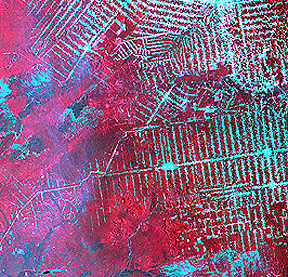
Radar imagery, which can penetrate cloud cover (see Section 8), is especially effective for short-term monitoring of changes in deforestation. This next image (courtesy NASDA) uses two JERS-1 SAR images taken 15 months apart to pinpoint the continuing enlargement of the edges of cleared strips. Preserved rain forest is shown in white; deforestation as of July 1992 appears in yellow; additional stripping up to October 1993 is marked in red. While the changes are not gross, the encroachment on remaining natural forests is obvious.
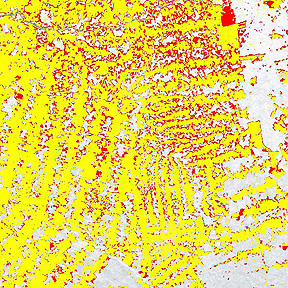
At a smaller scale, but nevertheless subject to continuing debate, is the stripping of whole tracts of woodlands in temperate and boreal forests to provide lumber and paper pulp. Loss of the redwoods in the western U.S. coastal forests is a typical situation. While current laws require reforestation of most such lands, the rate of regrowth in some regions is not keeping pace with removal. Some of these forestry applications can be nicely portrayed with several Landsat subscenes (below) of heavily timbered areas of Canada, as prepared by the Canadian Centre for Remote Sensing (CCRS) http://www.ccrs.nrcan.gc.ca/ccrs/homepage.pl?e. The first two cover an area near Port Renfro on Vancouver Island in British Columbia, in part of the Pacific Coastal Ranges with fir, spruce, and some deciduous trees. In this next subscene are a pair of TM images (each 7 x 15 km) taken on July 17, 1984 (left) and June 19, 1991.
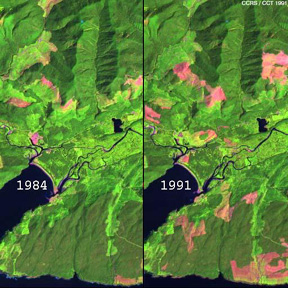
Each is processed with TM3 = B, 4 = G, and 5 = R (this makes active vegetation green). Clearcutting of the mixed forest in the year or so up to 1991 is in pink. Mature vegetation is darker green and regenerated forest appears in light green. Another way to carry out this change detection is to use a band from one year and two bands from the other year in making the color composite. Note this:
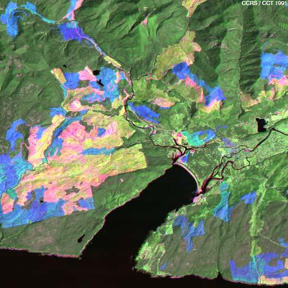
In this 15 x 15 km (9.3 x 9.3 miles) version, TM bands 4 and 5 from 1984 are assigned to green and red, and band 5 from 1991 is shown in blue. Once again, mature forest is rendered in dark green and reforested land in light green but here pink denotes areas that were recently deforested in 1984 and blue refers to areas that were clearcut between 1984 and 1991 but have yet to make a strong recovery.
We shift now to part of the boreal forestlands that are widespread on the Canadian Shield. The area (15 x 15 km) is in an isolated timber wilderness near Lac Nemiscau in northern Quebec:
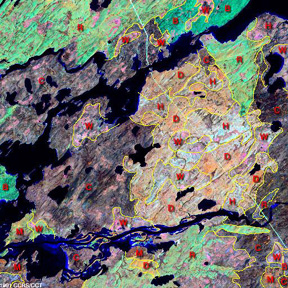
In this August 20, 1991 subscene, TM bands 5,4, and 3 have been assigned to red, green, and blue respectively. The Riviere de Rupert and associated water offshoots appear in black. Shades of bright green are identified as areas of recent, partially recovered fire burns (B in red lettering) or regenerated forest (R). Purple-gray denotes coniferous forests (C) and orange is deciduous forest (D). Small areas of wetlands and bogs (W) show as pinks; M refers to mixed forest, and H indicates heath (evergreen shrubs, similar to Scottish heather) with trees. Try to pick out the power line running to the north. This false color rendition is almost as graphic and definitive as a supervised classification, owing in part to the incorporation of the longer wavelength TM band 5.
Code 935, Goddard Space Flight Center, NASA
Written by: Nicholas M. Short, Sr. email: nmshort@epix.net
and
Jon Robinson email: Jon.W.Robinson.1@gsfc.nasa.gov
Webmaster: Bill Dickinson Jr. email: rstwebmaster@gsti.com
Web Production: Christiane Robinson, Terri Ho and Nannette Fekete
Updated: 1999.03.15.